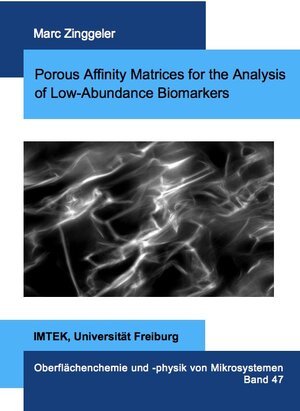
×
![Buchcover ISBN 9783843938259]()
Porous Affinity Matrices for the Analysis of Low-Abundance Biomarkers
von Marc ZinggelerAn important trend in the development of new diagnostic procedures is that medical diagnostic tests are performed on simple to use analytical devices at the point-of-care (POC), i. e., in the direct presence of the patient, rather than on large instrumentation in the centralized clinical laboratory. However, for many analytical targets the performance of the available POC devices is still insufficient. One of the reasons for this is that many biomarkers that are important for medical diagnostics are found in extremely low concentrations and are covered by the huge molecular and cellular background in the blood. To achieve the sensitivities which are required for the analysis of these low-abundance biomarkers, the interactions between the involved analytical surfaces and the biological sample need to be tightly controlled. To achieve this, highly target specific, porous hydrogel materials are generated from photoreactive copolymers in this work. These porous affinity matrices are integrated into simple fluidic systems in order to efficiently interact with their targets during the flow-through of a sample. Two systems, one for the analysis of a cellular and one for the analysis of a molecular target, are studied. For the analysis of circulating tumor cells (CTCs), an affinity membrane is generated by modifying the surface of a standard track-etched membrane with a thin, CTC-selective hydrogel layer. This layer is functionalized with antibodies against the epithelial cell adhesion molecule (EpCAM) which is typically expressed on the surface of CTCs. The modified membranes can be used in a simple dead-filtration setup and allow the efficient isolation of target cells from whole blood based on a unique combination of mechanical and molecular interaction with the membrane. For the analysis of low-abundance plasma proteins, like the inflammatory cytokine interleukin-6 (IL-6), functional porous hydrogel monoliths (cryogels) are directly generated inside a transparent glass capillary which serves as a microfluidic carrier. This assembly enables fluid flow by capillary action and simple optical detection. Hence, immunochromatographic assays similar to a classical lateral flow assay (LFA) can be performed. Both systems achieve excellent analytical performance in initial tests performed on spiked blood samples and are therefore promising candidates for the realization of highly sensitive POC diagnostic devices.


